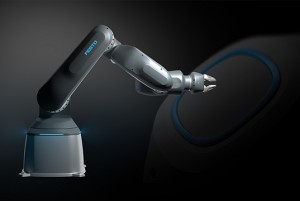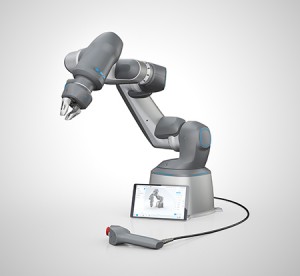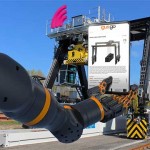Festo heralds new era of human-robot collaboration
 What if there was a robot that was easy to operate, did not require a safety fence and was also attractively priced? That would introduce a whole new era in human-robot collaboration. Festo says this new era is now dawning – with the world’s first pneumatic robot.
What if there was a robot that was easy to operate, did not require a safety fence and was also attractively priced? That would introduce a whole new era in human-robot collaboration. Festo says this new era is now dawning – with the world’s first pneumatic robot.
Collaborative robots as a market segment is set to grow rapidly over the next few years, relieving employees of particularly strenuous or monotonous tasks, giving them new levels of freedom and making their work easier and healthier. And pneumatics provides a sensitive and flexible approach to human-robot collaboration.
The Festo Cobot owes many of its advantages, such as its sensitivity, weight and value for money, to the benefits of pneumatics. The direct drives in the articulated joints are very cost-effective and particularly lightweight because, unlike electric solutions, no heavy gear units or expensive force-torque sensors are required. The world’s first pneumatic cobot is a result of the exceptional expertise in controlled pneumatics from Festo.
The Festo Cobot even makes using cobots cost-effective for small and medium-sized companies, which often rely on manual work processes. Its flexible application options mean that small batch sizes or work steps can now be processed automatically. Thanks to its intuitive and simple commissioning and programming, it is quick and easy to get to grips with so extensive training is not required.
 Festo says the pneumatic cobot will be cheaper than electric cobots in the same class. Its main application area is small parts handling with payloads of up to 3 kg, and it has a reach of 670 mm. “When it goes on sale in 2023, the Festo cobot will set new standards in human-robot collaboration with its ease of use,” explains Dr Frank Melzer, member of the board for product and technology management at Festo.
Festo says the pneumatic cobot will be cheaper than electric cobots in the same class. Its main application area is small parts handling with payloads of up to 3 kg, and it has a reach of 670 mm. “When it goes on sale in 2023, the Festo cobot will set new standards in human-robot collaboration with its ease of use,” explains Dr Frank Melzer, member of the board for product and technology management at Festo.
The Festo cobot consists of the hardware itself, a handheld module and the Robotic Suite – software for intuitive commissioning and programming. Festo claims this package makes it possible to commission and program the cobot in less than an hour. Prior knowledge of robotics is not required either, because the self-explanatory Robotic Suite software contains clearly visualised and standardised function blocks. Pneumatic drives enable the robot arm to be guided by hand easily and without any resistance so that waypoints or paths can be taught quickly and precisely.
For small and medium-sized companies in particular, cobots are only attractive if they can adapt quickly to take on a new task and are not just permanently used for the same purpose. The Festo cobot meets this requirement as it doesn’t require an additional control cabinet (which can be difficult to connect and cumbersome). The compact controller that is integrated in the cobot’s own base makes it particularly flexible. Simple connections also allow it to be used ad hoc without long changeover times. Common bus standards enable fast connection to higher-order controllers. It also requires less space.
Thanks to state-of-the-art, lightweight construction methods, the Festo cobot weighs in at well under 20 kg so that it can be deployed quickly and flexibly at other locations.
Visit the Festo website for more information















